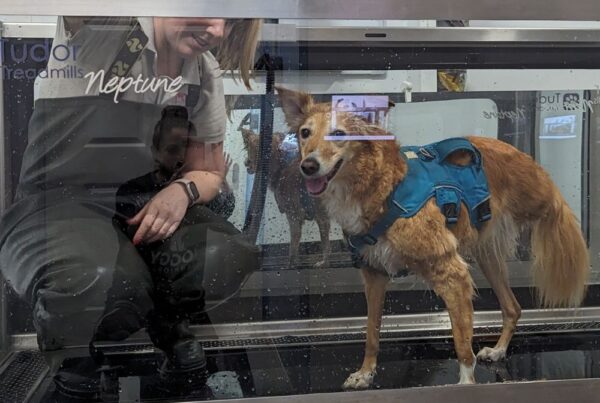
Have you adopted a dog from the UK or overseas and they came to you fearful, reactive or lacking in confidence? Perhaps it’s now a few months down the line and your rescue has begun to exhibit guarding behaviour over specific items or their home?
If you’re experiencing challenging behaviour from your rescue dog, know you’re not alone and try not to worry. There are many reasons why rescue dogs start to show unwanted behaviour, but luckily it is avoidable and most importantly, it is treatable.
Here are some of the most common behavioural challenges you might have to deal with when you adopt a rescue dog.
Lack of confidence
Something I often see in rescue dogs is a lack of confidence. This is something that not all owners will notice, particularly to begin with as the dog can be riding the wave of emotions that come with a new home and new surroundings, but this is a coping mechanism.
After they arrive in their new homes, dogs will often be walked within the first day, maybe the second, and they will sometimes have a new visitor within the first week. If they’re exposed to too many new things and have lots of interactions too soon, your rescue may start being reactive to other dogs and visitors to the house, barking at small noises and sometimes, they might stop and lie down on their walks.
Coming out of kennels or a foster home and going into a new home has a huge impact on dogs. They would have been used to a set routine, specific feeding times and possibly other dogs’ noises and scents.
The best thing you can do as a rescue dog’s new owner is give them time to decompress for the first few days in their new home. Try to make everything as simple as possible. Feed your dog from a snuffle mat or use Freework to encourage sniffing and stimulate the seeking system – this helps to release dopamine and lower anxiety in turn.
Try to give it a few days before walking your rescue, if not longer. When you do go out for those first few walks, stick to a route around your neighbourhood or a private field. Save the dog parks and beaches until your new pup has properly settled. You can use this time to find out more about your new canine friend – what toys do they like, what’s their favourite treat, do they like being stroked behind the ears or on the chest the best?
Fearful dogs
Fearful behaviour is most common in rescue dogs that come from overseas. Your dog has potentially lived in a different climate, a different environment, and perhaps they were housed with lots of other dogs. When you consider this, their arrival in the UK – a strange new place – and then the genetic and epigenetic component too, it all makes for a turbulent journey! Your dog’s world has been turned upside down – they didn’t know that they were heading for a better life and we are sometimes too quick to throw them into their new world at the deep end.
Dogs display fear in different ways with different triggers and situations. Your new dog could be fearful of men, children or other dogs to name a few examples. The tail carriage, ears, eyes and body posture can be clear indicators that your dog is feeling discomfort. They might also hide, shake, flee, bite and snap. They might also exhibit shut down behaviours like stillness, blank staring and sometimes, when forced into situations, they may seem quiet, calm and submissive.
Your efforts to reduce fearfulness in your rescue dog will benefit from a qualified force-free behaviourist, possibly combining psychopharmacological options with a behaviour modification programme. Simple steps can also be taken, like setting up a safe space for your dog to go where they can rest and enjoy some peace and quiet away from the main hustle of family life. You should also try to identify triggers and write them down to avoid them to begin with. Give your rescue more time to acclimatise to their new home and avoid luring them with food, as this can cause conflict within the dog.
Resource Guarding
Resource guarding can happen in any breed of dog, at any age and from any background. Having worked with 5-month-old bred puppies who guard their food and stolen items like tissues or socks to ex street dogs who guard their house and humans, I know that guarding can be a real issue if it’s not dealt with in the right way.
There are a few things that you can do to help prevent resource guarding before it happens, especially with those naughty puppies that like to steal items! It can be easy to get into the habit of chasing, but you should simply try to get those valuable items out of the way. Train your dog to ‘drop’ the stolen item and exchange it for an appropriate dog item, like a toy or a treat, rather than leaving them with nothing.
Avoid the old trick of taking food and bowls away from dogs so they get used to humans being around their food – this could make things a lot worse! Instead, why not add value at feeding time by using your presence around food as an indicator to show that nice things will become available when you are around. Speak to a qualified force-free behaviourist for help if you are stuck.
As with any of the above behaviours, you must make sure that your dog is not suffering from pain. Consult with a vet before you continue with any behavioural work.
You might also like to read: How long it takes to train a rescue dog.
About Sophie
Sophie Peacock is the business owner of The Rescue Dog Trainer and Lowhills Animal Behaviour Consultancy, Training & Pet Sitting based in Rugby, Warwickshire. A former Dog Warden and Animal Welfare Officer of 15 years, Sophie has worked with all types of dogs (and cats!) but specialises in fearful, nervous, reactive adopted dogs and ex street dogs from overseas.



